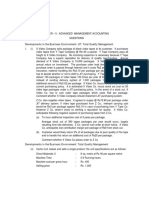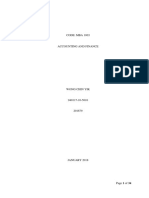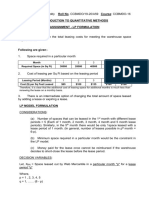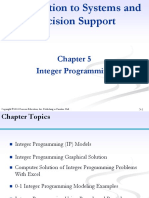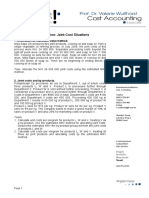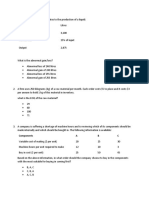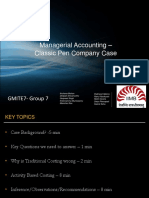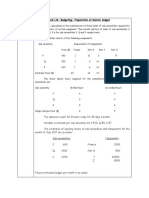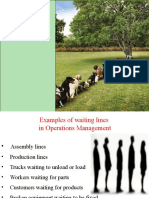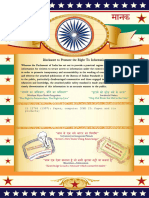Queuing: Waiting-Line Models
Problem 1:
A new shopping mall is considering setting up an information desk manned by one employee.
Based upon information obtained from similar information desks, it is believed that people will
arrive at the desk at a rate of 20 per hour. It takes an average of 2 minutes to answer a question. It is
assumed that the arrivals follow a Poisson distribution and answer times are exponentially
distributed.
(a) Find the probability that the employee is idle.
(b) Find the proportion of the time that the employee is busy.
(c) Find the average number of people receiving and waiting to receive some information.
(d) Find the average number of people waiting in line to get some information.
(e) Find the average time a person seeking information spends in the system.
(f) Find the expected time a person spends just waiting in line to have a question answered (time
in the queue).
Problem 2:
Assume that the information desk employee in Problem 1 earns $10 per hour. The cost of waiting
time, in terms of customer unhappiness with the mall, is $12 per hour of time spent waiting in line.
Find the total expected costs over an 8-hour day.
Problem 3:
The shopping mall has decided to investigate the use of two employees on the information desk.
(a) Find the probability of no people in the system.
(b) Find the average number of people waiting in this system.
(c) Find the expected time a person spends waiting in this system.
(d) Assuming the same salary level and waiting costs as in Problem 2, find the total expected costs
over an 8-hour day.
�Problem 4:
Three students arrive per minute at a coffee machine that dispenses exactly four cups per minute at
a constant rate. Describe the system parameters.
Problem 5:
A repairman at a local metal working shop services their five drill presses. Service time averages 10
minutes and is exponentially distributed. Machines breakdown after an average of 70 minutes
operation (following a Poisson distribution). Describe the major system characteristics.
�ANSWERS
Problem 1:
(a)
(b)
(c)
P0 1
20
1
0.33 33%
30
0.66
Ls
20
2 people
30 20
2
202
Lq
1.33 people
( ) 30(30 20)
(d)
(e)
(f)
Ws
1
1
0.10 hours
30 20
Wq
20
0.0667 hours
( ) 30(30 20)
�Problem 2:
From the solution to Problem 1:
The average person waits 0.0667 hours and there are 160(20 arrivals * 8 hours) arrivals per day.
Therefore: Total waiting time = 160 x 0.0667 = 10.67 hours
Total cost for waiting = Total waiting time * Cost per hour = 10.67 * $12 = $128 per day.
Salary cost = 8 hours * $10 = $80
Total cost = Salary cost + Waiting cost = $80 + $128 = $208 per day.
Problem 3:
20 per hour 30 per hour M 2 open channels (servers)
(a)
P0
1
0
1 20
1 20
1 20
0! 30
1!
30
2 30
2(30)
2(30) 20
1
2 1 4
60
1
3 2 9 60 20
1
1
50%
2 1 2
1
3 3
�(b)
20
30
(1)[(2)(30) 20]2
(20)(30)
Ls
20
1
30
2
800
3 1 2
1600 2 3
1 8
0.75 people
12 12
(c)
Ws
Ls 0.75
0.0375 hours
20
Problem 4:
Lq
2
1.125
2 ( )
people in the queue on average
Wq
0.375
2 ( )
minutes in the queue waiting
Ls Lq
1.87
people in the system
Ws Wq
1
0.625
minutes in the system
�Problem 5:
N=5
T = 10 minutes
U = 70 minutes
M = 1 server
X
T
10
0.125
T U 10 70
From Table D.8: where X = .125 and number of service channels = 1, D = 0.473, F = 0.920
Average number waiting = L = N(1 F) = 5(1 0.920) = 0.4
Average number of machines running = J = NF(1 X) = 5(0.920)(1 0.125) = 4.025 machines
Average number of machines being serviced = H = FNX = (0.920)(5)(0.125) = 0.575 machines
Probability of no wait = 1 D = 1 0.473 = 0.527
�Capacity Planning
Problem 1:
The design capacity for engine repair in our company is 80 trucks/day. The effective capacity is 40
engines/day and the actual output is 36 engines/day. Calculate the utilization and efficiency of the
operation. If the efficiency for next month is expected to be 82%, what is the expected output?
Problem 2:
Given: F fixed cost $1000
V variable cost $2 / unit
P selling price $4 / unit
Find the break-even point in $ and in units.
Problem 3:
Develop the break-even chart for Problem 2.
Problem 4:
Jacks Grocery is manufacturing a store brand item that has a variable cost of $0.75 per unit and a
selling price of $1.25 per unit. Fixed costs are $12,000. Current volume is 50,000 units. The
Grocery can substantially improve the product quality by adding a new piece of equipment at an
additional fixed cost of $5,000. Variable cost would increase to $1.00, but their volume should
increase to 70,000 units due to the higher quality product. Should the company buy the new
equipment?
Problem 5:
What are the break-even points ($ and units) for the two processes considered in Problem 4?
Problem 6:
Develop a break-even chart for Problem 4.
Problem 7:
Good News! You are going to receive $6,000 in each of the next 5 years for sale of used machinery.
A bank is willing to lend you the present value of the money in the meantime at discount of 10%
per year. How much cash do you receive now?
7
�ANSWERS:
Problem 1:
Utilization =
Actual output
36
45%
Design capacity 80
Efficiency =
Actual output
36
90%
Effective capacity 40
Expected Output (Effective capacity) (Efficiency)
(40)(0.82) 32.8 engines/day
Problem 2:
Break-even point($) BEP($)
Break-even point( x) BEP ( x )
F
1000 1000
$2, 000
V
2
0.5
11P
4
F
1000
500
P-V 4 2
Problem 3:
�Problem 4:
Profit = TR TC
Option A: Stay as is:
Profit 50, 000*(1.25 .75) 12, 000 $13, 000.
Option B: Add equipment:
Profit 70, 000 *(1.25 1.00) 17, 000 $500.
Therefore the company should continue as is with the present equipment as this returns a higher
profit..
Problem 5:
Using current equipment:
BEP($)
BEP ( x )
F
12, 000 12, 000 12, 000
$30, 000
V
0.75 1 0.60
0.40
1
1
P
1.25
F
12, 000
24, 000
P V 1.25 0.75
Using the new equipment
BEP($)
BEP( x)
F
17, 000 17, 000 17, 000
$85, 000.
V
1.00 1 .80
0.2
1
1
P
1.25
F
17,000
17,000
68,000.
P V 125
. 100
.
0.25
�Problem 6:
Problem 7:
The net present value factor for 10% and 5 years is 3.79
(3.79 0.909 0.826 0.751 0.683 0.621)
Therefore, the present value is: 3.79 * $6,000 $22,740
The Bad News is you do have to pay back the loans!
10
�Human Resources and Job Design
Problem 1:
Develop a Process Chart for making a grilled cheese sandwich.
Problem 2:
Develop an Activity Chart for doing three loads of laundry.
Problem 3:
Develop a Process Chart for changing the oil in an automobile.
Problem 4:
Develop an Activity Chart for writing a term paper.
11
�ANSWERS
Problem 1:
One possible solution. The level of detail in process charts depends upon the requirements of the
job. Time is often included to aid analysis of value added.
Process Chart
Distance
Symbol
Process Description
10
Move to cabinet
Get loaf of bread
Move to counter
Open loaf of bread
Remove two slices of bread
Lay slices on counter-top
Close loaf of bread
Move to cabinet
Replace loaf of bread on shelf
10
Move to refrigerator
Get mustard, package of ham
from refrigerator, and butter
10
Move to counter
Open package of ham
Remove two slices of ham
Close package of ham
Open mustard
Spread mustard on bread
Close mustard
12
Place ham on bread
Close sandwich
Open butter
Spread butter on top slice of
bread
Move to stove
Get fry pan
Turn heat on under fry pan
Wait for pan to heat
Move to counter
Get sandwich & butter
Move to stove
Place sandwich, buttered-side
down in pan
Butter top slice
Close butter
Move to counter
Pick up ham, mustard, and
butter
10
Move to refrigerator
Return butter, mustard, and
ham to refrigerator
Move to stove
Wait for sandwich to brown on
bottom
Inspect
Flip sandwich
13
Wait for sandwich to brown on
bottom
Inspect sandwich
10
Move to serving area
Serve sandwich
14
�Problem 2:
Time
Operator
Machine
1
Machine
2
Washer
Dryer
Load
Being
clothes and loaded
detergent
in to
Machine 1
Idle
Idle
Run
Idle
Remove
clothes
from
Machine 1
Being
unloaded
Idle
Load
clothes
into
Machine 2
Idle
Being
loaded
Load
Being
clothes and loaded
detergent
into
Machine 1
Run
Idle
Run
Run
Remove
clothes
from
Machine 2
Idle
Being
unloaded
Hang
clothes
Idle
Idle
Problem 3:
One solution might be:
Process Chart for
Changing Oil in Car
Distance
Symbol
Check that needed filter is in
stock
Check that oil is in stock
15
�30
Move to car
Get into car
Start engine
Idle car to warm engine
Drive car onto lift
Stop engine
Release hood catch
Get out of car
10
Go to lift control
Raise lift
10
Go to toolbox
Get wrench
Get container for drained oil
Get rag
10
Walk under lift
Wipe around oil drain plug
Loosen oil drain plug
Position container
Remove oil drain plug
Drain oil
Wipe around oil drain plug
Replace oil drain plug
Tighten oil drain plug
20
Remove container to disposal
area
16
�15
Move to lift control
Lower lift
Wipe oil from wrench
Move to toolbox
Return wrench to tool chest
Get oil filter wrench from tool
chest
Get container for drained oil
10
Move to car engine area
Raise hood
Find oil filter
Loosen oil filter
Position container
Remove oil filter
20
Take old filter and container of
drained oil to disposal area
25
Move to filter stock area
Get new filter
25
Move to car engine area
Wipe around filter mount oil
seal
Install new filter
Tighten new filter
Remove oil filler cap
40
Move to oil stock
Get oil from stock
Move to car engine
compartment
17
�Open oil container; pour in oil
filler
Replace oil filler cap
Clean hands
Start engine
Idle engine
Stop engine
Check oil level
Check oil filter seal
Check oil drain plug
Wipe up any spilled oil
Take empty oil containers to
disposal area
Wipe oil from oil filter wrench
25
Return oil filter wrench to tool
chest
Start engine
Drive car off lift
Park car for owner pickup
Return keys
18
�Problem 4:
Activity Chart for Writing Term Paper
Time
Operator
Computer
1
Computer
2
Desktop
Library
Develop topic
Used for
word
processing
Develop initial
outline
Used for
word
processing
Research
Flesh out
outline with
information
from research
Used for
look-up
and web
search
Used for
word
processing
Evaluate paper
Final edit paper Used for
word
processing
Proof read
paper
Used for
word
processing
Print final copy Used for
of paper
printing
Does this Activity Chart contain enough detail that you could estimate the time it would take to
write the term paper?
Aggregate Planning
Problem 1:
Set the following problem up in transportation format and solve for the minimum cost plan.
19
�Period
Feb
Mar
Apr
55
70
75
Regular
50
50
50
Overtime
Subcontract
12
12
10
Beginning Inventory
10
Demand
Capacity
Costs
Regular time
$60 per unit
Overtime
$80 per unit
Subcontract
$90 per unit
Inventory carrying cost
$1 per unit per month
Back order cost
$3 per unit per month
ANSWERS
Problem 1:
20
�Location Strategies
Problem 1:
21
�A major drug store chain wishes to build a new warehouse to serve the whole Midwest. At the
moment, it is looking at three possible locations. The factors, weights, and ratings being considered
are given below:
Ratings
Factor
Weights
Peoria
Des Moines
Chicago
Nearness to markets
20
Labor cost
Taxes
15
Nearness to suppliers
10
10
10
Which city should they choose?
Problem 2:
Balfours is considering building a plant in one of three possible locations. They have estimated the
following parameters for each location:
Location
Fixed Cost
Variable Cost
Waco, Texas
$300,000
$5.75
Tijuana, Mexico
$800,000
$2.75
Fayetteville, Arkansas
$100,000
$8.00
For what unit sales volume should they choose each location?
Problem 3:
Our main distribution center in Phoenix, AZ is due to be replaced with a much larger, more modern
facility that can handle the tremendous needs that have developed with the citys growth. Fresh
produce travels to the seven store locations several times a day making site selection critical for
efficient distribution. Using the data in the following table, determine the map coordinates for the
proposed new distribution center.
22
�Store Locations
Map Coordinates (x,y)
Truck Round Trips per Day
Mesa
(10,5)
Glendale
(3,8)
Camelback
(4,7)
Scottsdale
(15,10)
Apache Junction
(13,3)
Sun City
(1,12)
Pima
(5,5)
10
23
�Problem 4:
A company is planning on expanding and building a new plant in one of three countries in Middle
or Eastern Europe. The general manager, Patricia Donegal, has decided to base her decision on six
critical success factors: technology availability and support, availability and quality of public
education, legal and regulatory aspects, social and cultural aspects, economic factors, and political
stability.
Using a rating system of 1 (least desirable) to 5 (most desirable) she has arrived at the following
ratings (you may, of course, have different opinions). In which country should the plant be built?
Critical Success Factor
Turkey
Serbia
Slovakia
Technology availability and support
Availability and quality of public education
Legal and regulatory aspects
Social and cultural aspects
Economic factors
Political stability
Problem 5:
Assume that Patricia decides to use the following weights for the critical success factors:
Technology availability and support
0.3
Availability and quality of public education
0.2
Legal and regulatory aspects
0.1
Social and cultural aspects
0.1
Economic factors
0.1
Political stability
0.2
Would this change her decision?
24
�Problem 6:
Patricias advisors have suggested that Turkey and Slovakia might be better differentiated by either
(a) doubling the number of critical success factors, or (b) breaking down each of the existing
critical success factors into smaller, more narrowly defined items, e.g., Availability and quality of
public education might be broken into primary, secondary, and post-secondary education. How
would you advise Ms. Donegal?
25
�ANSWERS:
Problem 1:
Ratings
Weighted Ratings
Weights
Peoria
Des
Moines
Chicago
Peoria
Des
Moines
Chicago
Nearness to
markets
20
80
140
100
Labor cost
40
40
20
Taxes
15
120
135
105
Nearness to
suppliers
10
10
10
100
60
100
Sum of Weighted ratings:
340
375
325
Factor
Therefore, it appears that based upon the weights and rating, Des Moines should be chosen.
26
�Problem 2:
Transition between Waco and Tijuana:
300, 000 (5.75 x) 800, 000 (2.75 x)
3 x 500, 000
x 166, 000
Transition between Waco and Fayetteville:
300, 000 (5.75 x ) 100, 000 (8.00 x)
200, 000 2.25 x
88,888 x
27
�Problem 3:
New Distribution Center should be located at:
Cx
(10*3) (3*3) (4* 2) (15* 6) (13*5) (1*3) (5*10) 255
7.97
3 3 2 6 5 3 10
32
Cy
(5*3) (8*3) (7 * 2) (10* 6) (3*5) (12 *3) (5*10) 214
6.69
3 3 2 6 5 3 10
32
28
�Problem 4:
Critical Success Factor
Turkey
Serbia
Slovaki
a
Technology availability and support
Availability and quality of public education
Legal and regulatory aspects
Social and cultural aspects
Economic factors
Political stability
23
19
22
Based upon her ratings of the critical success factors, Patricia should choose Turkey. From a
practical perspective, given the small difference between the scores for Turkey and Slovakia, and
the subjectivity of the ratings themselves, Patricia would be better advised to develop additional
critical success factors, more carefully weigh the individual factors; or, in general, to acquire more
information before making her decisions.
29
�Problem 5:
Critical Success Factor
Wgt
Turkey
Serbia
Technology availability and support
0.3
1.2
0.9
1.2
Availability and quality of public
education
0.2
0.8
0.8
0.6
Legal and regulatory aspects
0.1
0.2
0.4
.5
Social and cultural aspects
0.1
0.5
0.3
0.4
Economic factors
0.1
0.4
0.3
0.3
Political stability
0.2
0.8
0.4
0.6
= 3.9
Slovaki
a
3.1
3.6
No, in this case, use of the weighting factors does not change the recommendation. One might
again suggest that additional information be considered in making the decision.
Problem 6:
(a) Doubling the number of critical success factors. There are two issues here. First, from a
practical perspective there are a limited number of truly critical success factors and these
should be the ones presently being considered. Any additional factors should be of secondary
or tertiary importance. Second, given the subjective nature of the rating process, adding
additional factors would also increase the overall margin of error of the final ratings to a degree
that may eliminate any gain in differentiation arising from the use of the additional factors. The
use of a maximum of seven to nine critical success factors is usually appropriate.
(b) Given that ones ability to estimate or rate an aggregate is usually better than ones ability to
estimate or rate the individual components of the aggregate, this approach is unlikely to
provide much help.
Layout Strategy
30
�Problem 1:
As in most kitchens, the baking ovens in Loris Kitchen in New Orleans are located in one area
near the cooking burners. The refrigerators are located next to each other as are the dishwashing
facilities. A work area of tabletops is set aside for cutting, mixing, dough rolling, and assembling of
final servings, although different table areas may be reserved for each of these functions.
Given the following Interdepartmental Activity Matrix, develop an appropriate layout for Loris
Kitchen.
Interdepartmental Activity Matrix
Cooking burners (A)
Cooking
Burners (A)
Refrigerators (B)
Dishwashing (C)
Work Area (D)
193
12
82
222
Refrigerator (B)
Dishwashing (C)
Work Area (D)
The present layout is:
A
with a distance of 10 feet between adjacent areas.
31
�Computing the Load * Distance measure:
Load * Distance
A to B
7 * 10
A to C
193*20
A to D
12*30
B to C
4*10
B to D
82*20
C to D
222*10
Total
70
3860
360
40
1640
2220
8190
Develop a preferred layout. What is the sum of the loads * distance of your new layout?
32
�Problem 2:
A firm must produce 40 units/day during an 8-hour workday. Tasks, times, and predecessor
activities are given below.
Task
Time (Minutes)
Predecessor(s)
10
D, E
Total
38 minutes
Determine the cycle time and the appropriate number of workstations to produce the 40 units per
day.
33
�ANSWERS
Problem 1:
From the Activity Matrix, C and D should be next to each other and A should be next to C. The
other relationships are minor by comparison. One possible solution is:
B
with a distance of 10 feet between adjacent areas.
Computing the Load * Distance measure:
Load * Distance
A to B
7 * 10
70
A to C
193*10
1930
A to D
12*20
240
B to C
4*20
80
B to D
82*30
2460
C to D
222*10
2220
7000
Total
Further improvement is possible. Try analyzing the following layouts.
A
Problem 2:
Cycle time
Production time available 8 hrs *60 minutes/hr 480
12 minutes/cycle
Units required
40 units
40
34
�Minimum number of workstations
Cycle time
Work time required
Cycle time
38 minutes
3.17 station
12 minutes/cycle
3.17 workstations must be rounded up to 4 as 3 workstations would not be able to produce the
required output.
One layout not necessarily optimal
35








